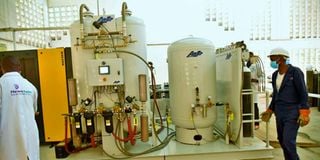Kenya’s big oxygen plants lie

An oxygen production machine at Nakuru Level Five Hospital.
Amid the Covid-19 outbreak three years ago, every county was in a hurry to set up an oxygen plant. This was due to projections that public hospitals would be overwhelmed with patients in need of critical care.
Many counties got into public-private partnerships to finance the refining of the gas, with others importing machines.
Had the noble ambition progressed as envisaged, the country could now be boasting of surplus medical oxygen.
However, what most public hospitals are left with are oxygen cylinders. Patients in need of gas are struggling to access it.
The Sunday Nation has learnt that bribes, tendering bottlenecks, poor training of staff handling the facilities, lack of spare parts and poor quality medical oxygen have rendered some plants unusable.
Most counties are getting their suppliers from BOC Gases Ltd, the leading supplier of industrial, medical and special gases in East and Central Africa.
Oxygen is a critical component in emergency respiratory resuscitation. In fact, it features on the World Health Organisation’s (WHO) list of essential medicines.
Oxygen therapy is not just for pneumonia and lung diseases.
The gas is also crucial in the treatment of non-respiratory conditions that result in an abnormally low concentration of oxygen in the blood (hypoxaemia), such as sepsis, severe malaria, trauma and cardiovascular illnesses. It is equally important for surgical care and anaesthesia.
Medical oxygen is commonly administered in hospitals and clinics.
It is used during anaesthesia, first aid resuscitation, life support for patients who cannot breathe on their own and therapy.
According to the WHO, oxygen therapy is recommended for severe and critical patients.
Oxygen flows
A survey of emergency care centres across Kenya found that more than 30 per cent do not have a regular supply of oxygen.
Close to 90 per cent of those with the gas do not have piped oxygen in the emergency departments and deliver oxygen directly from tanks to patients.
“In some private hospitals, oxygen flows from the walls. But many do not have piped oxygen,” said Benjamin Wachira, an assistant professor of emergency medicine at Aga Khan University.
He added that many public hospitals were not built with oxygen piping, a situation that continues despite piping being standard.
That, Prof Wachira said, forces hospitals to operate on a tank system.
“If a hospital has 15 patients requiring oxygen at the same time, it means 15 tanks are needed. This is not practical or affordable for hospitals or patients,” said Prof Wachira, the president of the African Federation for Emergency Medicine.
There are varying narratives on the fate of oxygen plants in counties.
Kakamega is one of the sad stories of an expensive project that never took off.
There was excitement when news of the delivery of an ultra-modern oxygen equipment to the county broke.
But the hype dissipated once the machines arrived in Kakamega.
The promises made by leaders remained just that – promises.
In July 2021, Kakamega imported Sh100 million medical oxygen equipment from France. The importer was Total Hospital Solutions.
Once installed, the equipment was expected to pump 1,000 litres of the gas a minute.
Total Hospital Solutions official, Bernard Karoro, took journalists on a tour of the “state-of-the-art” gadgets.
He assured the public that the plant would be up and running in a week.
“I have contracted five biomedical engineers who will get it up and running in no time. In fact, we started unpacking the machine today,” he said.
Save thousands of live
Nineteen months later, the gadget that was described in superlatives, and which was touted as a miracle that would bring to an end the shortage of oxygen in hospitals and save thousands of lives, is still packed in boxes at Kakamega Level Six County Teaching and Referral Hospital.
The hospital is still grappling with emergency-related critical cases and referring patients to Kisumu, Uasin Gishu and other counties.
The devolved government spends Sh2.8 million every month on oxygen from Kisumu.
In 2021, then-governor Wycliffe Oparanya said the plant could produce enough oxygen for hospitals in Kakamega and neighbouring counties.
Current governor, Fernandes Barasa, is struggling to make the plant operational even as the devolved government grapples with financial difficulties.
County health officials declined to give details on what could have delayed the installation of the equipment.
But sources at the hospital blamed the situation on building of a separate structure for the plant.
“Construction of the building is expected to be complete in April,” a county official told the Sunday Nation.
It is the same script in Homa Bay County, where millions of shillings was pumped into establishing an oxygen plant. The machine broke down even before it could start working. Emergency cases are referred to Kisumu and Kisii.
Homa Bay Referral Hospital CEO, Peter Ogolla, says there are no plans to repair the plant.
“A sustainable way of getting oxygen is the plant. The government must prioritise this,” he said.
Hospitals across Homa Bay rely on oxygen bought from BOC Gases Ltd. A 3,200-litre oxygen tank was installed at the referral hospital at the peak of the pandemic.
Dr Ogolla says the Sh4 million cylinder is refined through support from Amref. The hospital uses 71 litres of oxygen a day.
“We refill the tank every six weeks. The partnership is supported by the US,” he said.
Should the support end, the county government will spend Sh800,000 on refilling the tank every month.
The oxygen plant in Taita Taveta County is dead. Even piping has not been done on the rusting Sh14 million machine.
County officials and ward representatives have described it as a shocking waste of funds.
“There is no hope of this plant working to the expected capacity. We are thinking of doing away with it,” Health executive Gifton Mkaya said.
The project meant to save the county from buying oxygen started in 2019 and was completed the following year.
The plant began operating but experienced many breakdowns. It was also to supply oxygen to other hospitals, including Taveta, Mwatate and Wesu.
The plant was to produce more than 20 cylinders of oxygen daily and cut frequent trips to Mombasa.
“We are still using millions of shillings to buy oxygen and rent cylinders from BOC Kenya. We could save a lot but the plant is not working,” he said.
Mr Mkaya said Moi County Referral Hospital consumes up to 40 cylinders of oxygen a week.
The executive added that the devolved could embark on an new oxygen plant project.
“We cannot keep on spending money on what can be produced locally. This plant is unreliable,” he said.
An insider at Moi Hospital Referral told the Sunday Nation that the compressor broke down almost a year ago.
“The contractor is sourcing spare parts from abroad. We don’t know when he will fix the problem,” the official added.
The sad tale is replicated in Isiolo, where the county’s oxygen plants have even attracted the attention of the Ethics and Anti-Corruption Commission (EACC).
In November 2022, the commission recovered Sh18 million paid by the county government for the two plants.
The amount was recovered from an exaggerated cost in the procurement of and installation of the plants five years ago.
The contract to install the plants at Garbatulla Hospital and Isiolo Referral Hospital was awarded to Hitmax Ltd despite the firm not being the lowest bidder.
An EACC investigation following a complaint in September 2018 established that the quoted price had been inflated.
The company had quoted Sh53 million for the plant at the referral hospital and Sh27 million. The quotation for both tenders was Sh79.9 million.
Upper Eastern EACC boss, Charles Rasugu, said an independent valuation showed that the two plants cost Sh61 million.
“The valuation by the EACC established that the cost had been inflated, prompting the filing of a suit to recover the funds,” he said.
The money trail led detectives to Sh13 million held in two accounts, which the court allowed the agency to preserve.
In Kisumu, Governor Anyang Nyong’o said the oxygen plant is capable of producing “more than enough gas” to supply hospitals in the county.
With the frequent breakdowns, however, the plant can only serve Jaramogi Oginga Odinga Teaching and Referral Hospital and its ambulances.
In 2021, Kisumu County built a Sh50 million plant with capacity to produce 600 litres of oxygen per minute.
Prof Nyong’o said capacity of the plant is three times that of the previous one used at the hospital.
Mr Daniel Mudhama, a biomedical engineer operating the plant, said it can only fill 10 cylinders of oxygen a day.
“To produce more oxygen, we need a bigger machine, another transformer and a standby generator,” Mr Mudhama said.
A junior staff at one of the sub-county hospitals said the institutions at times go for hours or even a day before getting the gas.
In contrast, the Sh22 million plant at Kisii Teaching and Referral Hospital (KTRH) is up and running.
The county has a high-capacity plant to replenish the ventilator and supplies oxygen to hospitals in the region.
“At KTRH, we have an oxygen purifying plant. It supplies packed oxygen to hospitals in and out of this county,” a worker at the hospital told the Sunday Nation.
Before installing the plant at KTRH, the devolved government used Sh1.2 million every month to buy oxygen and rent cylinders from BOC Gases Ltd.
After investing Sh22 million in the plant, the hospital has enough oxygen for its needs.
The excess is sold to private hospitals and the money used to maintain the plant.
The hospital can fill up to 10 cylinders a day.
A reliable supply of oxygen in Kisii has seen a reduction in infant deaths from 46 to 40 per 1,000 births.
Nyamira Referral Hospital also has a functioning oxygen plant.
According to Governor Amos Nyaribo, the plant has substantially reduced the number of referrals the hospital had been making.
He added that the plant has reduced the cost of accessing oxygen.
Mr Nyaribo said the gas is also supplied to other hospitals in the county.
The plant, he added, produces 216,000 litres of oxygen a day, filling 10 huge cylinders which take 8,300 litres.
Many rural hospitals in Kenya lack supplementary oxygen equipment, adequate supply chains for cylinders and reliable electricity for delivery.
Most hospitals depend entirely on BOC Gases Ltd for medical oxygen cylinders.
However, BOC Gases Ltd has received criticism for high prices of its oxygen, inconsistent delivery, demanding additional deposits for cylinders and not providing oxygen in case of an outstanding balance.
Reported by Angela Oketch, Benson Amadala, George Odiwuor, Lucy Mkanyika, Angeline Ochieng and Ruth Mbula





